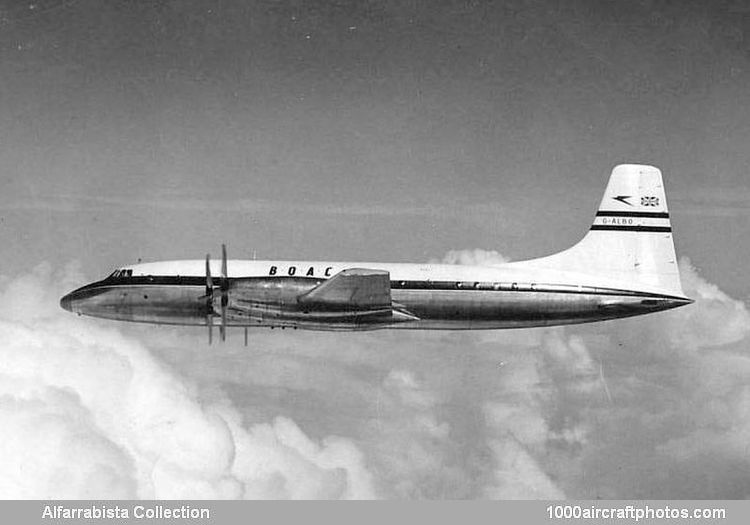06/30/2014. Remarks by Johan Visschedijk: "The Type 175 Britannia was Bristol's response to a 1947 BOAC requirement for a medium-range Empire transport. In its earliest form it was a Centaurus-powered 32 or 36-passenger aircraft. But since the engines were more powerful than was necessary for the specified payload it was decided to increase the gross weight and thus the passenger capacity to 40 or 44, depending on configuration. In July 1948 the Ministry of Supply ordered three prototypes of the Centaurus-powered aircraft, the second and third prototypes to be suitable for conversion to Proteus gas turbines.
Having taken a positive interest in the Proteus-engined version in October 1948, BOAC finally signed a contract for 25 in the following July, by which time the design had crystallized as an 83-seat aircraft capable of transatlantic operation at a gross weight of 130,000 lb (58,967 kg).
Only two prototypes, G-ALBO and G-ALRX, were actually built, the third airframe becoming the functional mockup. G-ALBO first flew at Filton on August 16, 1952, powered by four Proteus 625s. These engines were later changed for the definitive aircraft' s Proteus 705s, rated at 3,780 eshp. After a large amount of development flying the corporation put its Britannia 102s to work on the Johannesburg route from February 1957, and on services to Australia during the following month.
Of the initial order for 25 Britannias, fifteen were completed as 102s and the other ten were reserved for completion in the form of a projected higher-capacity version. The first of these stretched aircraft were designated Britannia 300 and, powered by Proteus 755s, could carry up to 99 tourist-class passengers. First flight of the prototype Britannia 301 took place in July 1956, by which time overseas interest in this variant had increased.
BOAC relinquished its claim to the Britannia 302s under construction, which were then delivered to Aeronaves de Mexico, Transcontinental SA, Air Charter and Ghana Airways. BOAC's major order for improved Britannias covered eighteen Britannia 312s. Deliveries began in September 1957 and transatlantic services started in December of that year.
Other customers for 300-series aircraft included El Al, which had four Britannia 313s, Canadian Pacific with six Britannia 314s, Hunting Clan and Cubana. Final version was the 4,445 ehp Proteus 765-powered Britannia 324, of which just two were completed for Canadian Pacific; these aircraft later passed into the hands of British Eagle as G-ARKA and G-ARKB. This airline acquired a good proportion of the BOAC fleet, which had been retired in 1965. By the mid-1970s almost all of the long-range Britannias had been withdrawn from airline use.
G-ALBO was reregistered to the Ministry of Supply on June 25, 1951, and was used for development testing of engines. On October 31, 1960 registration was cancelled as the aircraft was transferred to the Air Ministry. Under the number 7708M it became a ground-instruction airframe at RAF Saint Athan, Wales, where it was scrapped in 1968."
